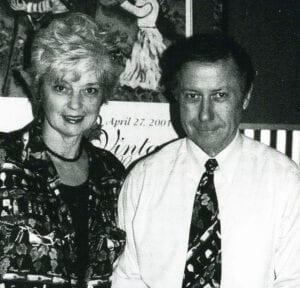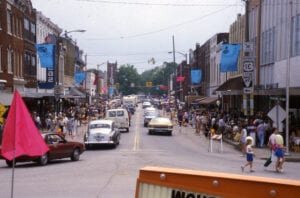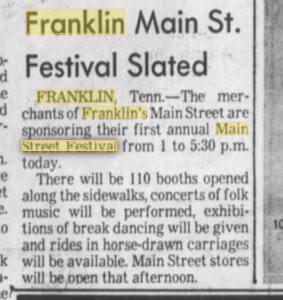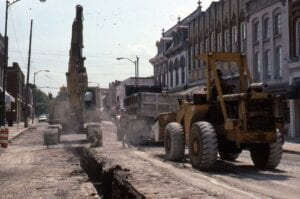The Heritage Foundation’s headquarters, the LeHew Magid Big House for Historic Preservation, is named for three beloved Foundation friends – Calvin and Marilyn LeHew and Emily Magid. The walls of the Big House tell a brief history of these friends; specifically, a portion of the LeHews’ story begins to paint a picture of how Franklin became the vibrant town of today:
Calvin LeHew, an entrepreneur, preservationist and community leader, grew up above his father’s country store in Hillsboro, which is now called Leiper’s Fork, just a few miles from Franklin. In 1964, he married Marilyn who is from Pennsylvania. Calvin credits much of his success to Marilyn, who has seen him through three near bankruptcies, as well as five plane crashes. Calvin once said, “I live on the edge. If you don’t go out on the edge, you don’t know where you can go.” Calvin and Marilyn have gone far.
Through Calvin’s travels abroad, he had a great vision for Franklin to attract visitors to this quaint, family-friendly small town. His vision became a reality when he developed Carter’s Court on Columbia Avenue across from the Carter House, a Civil War house museum. This charming nook touted 26 shops and restaurants, including Miss Daisy’s Tearoom. Attracting 300 people per day in the 1980s, this attraction was ranked Tennessee’s 7th tourist destination. In fact, Wynonna Judd was a waitress before finding fame as a country music star.
1980-1989
Carter’s Court was truly downtown Franklin’s first foray into the tourism industry. Locals with a vested interest in economic development and the revitalization of downtown knew there could be an opportunity to drive tourism to Main Street. Many of the regional hotels, including Opryland in Nashville, would bus hundreds of visitors to Franklin. They would visit Carter’s Court and other area shops and restaurants.
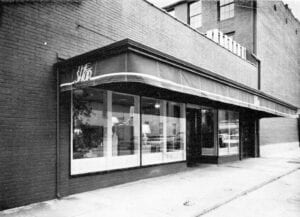
Used as a model for streetscape, the late Ed Stolman’s spot that is now Franklin Mercantile. Credit: Rick Warwick, Williamson County Historical Society
In 1984, a more formalized effort began with the forming of the Downtown Franklin Association (DFA). Following her tenure as the Heritage Foundation’s executive director from 1978-1986, Rudy Jordan became DFA’s executive director from 1986-1998 and was vital to the organization’s development and success. In order to further revitalize downtown, the DFA began working with downtown building and business owners. The focus was on strategies to beautify and strengthen the downtown core. Nearly a decade later, the organization would term this effort “streetscape,” as more businesses joined the movement.
In its founding year, DFA joined forces with other organizations like the Heritage Foundation to create the first Main Street Festival, to again, drive tourism to downtown Franklin. The festival, held on April 29, 1984, drew 15,000 people and included “110 booths opened along the sidewalks, concerts of folk music will be performed, exhibitions of break dancing will be given and rides in horse-drawn carriages will be available.” In a 2006 Tennessean article, Rudy Jordan recalls, “During the first year everyone went home because it started raining and we didn’t think anyone was coming. Everybody started calling and we had to get all of the merchants back downtown to set up.” Two years later, the attendance had doubled to 30,000 and new elements were added such as the “Strutters’ Ball” the night before the festival, drawing 150 attendees in the newly renovated Franklin Theatre.
1990-1999
One could say the 1990s were the Golden Age for Franklin. There was a huge development boom with the grand opening of Cool Springs Galleria in 1991, the opening of the downtown Franklin post office in the mid-90s and the completion of streetscape efforts toward the end of the decade. The DFA and Franklin received major recognition for the revitalization work, earning the title “Great American Main Street” from the National Trust for Historic Preservation and its division Main Street America. The 1997 Main Street Festival was evidence of the growth and success of the time, reaching 100,000 attendees.
[carousel_slide id=’27763′]
By 1998, DFA and the Heritage Foundation realized they were stronger together; the two organizations merged. In addition to private investments to restore and rehabilitate the facades of downtown buildings, the public-private partnership between the Heritage Foundation, Downtown Franklin Association and the City of Franklin led to the most significant changes.
The City saw the streetscape initiative as an opportunity to address some longstanding infrastructure improvements. The organizational partners also decided that running the power lines underground, resurfacing the streets, adding new light fixtures with more historic character and more were best completed during this time. These strides are a significant part of what makes Franklin the picturesque place we know today.
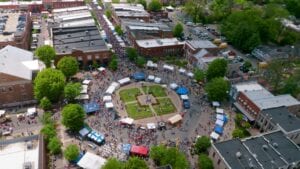 2000-2019
2000-2019
The 2000s saw steady growth both in population and visitation for the county. Robert Hicks’ writing and publication of his famous book The Widow of the South in 2005 had a palpable impact on Franklin tourism. The largest population and housing growth happened in 2006, just prior to the Great Recession. The Heritage Foundation also formed its longest standing corporate partnership with then First Tennessee Bank, now First Horizon Bank during the 2000s. To this day, the bank is still the longest running corporate partner for the Foundation and often is the presenting sponsor of the Main Street Festival.
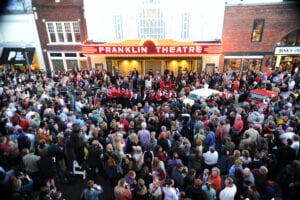
After saving The Franklin Theatre with the help of thousands of local donors and supporters as well as the critical support of angel donor Emily Magid, The Heritage Foundation spearheaded a multi-year restoration and rehabilitation project. The Franklin Theatre grand opened in its current form in 2011. Until this milestone, much of downtown would go dark in the early evening. Having the Theatre reopened and showing both concerts and movies well into the evening was another critical happening in the revitalization of downtown.
2020
This year, we venture into a new decade – one that we won’t soon forget – nor do we want to. Main Street is open for business, just as it has been for decades. It may look and operate a little differently than it has in the past, but our tried-and-true Downtown Franklin Association members are just as ready to welcome you.
Although we should have been hosting our 37th Annual Main Street Festival this weekend, rescheduled and then cancelled due to both the pandemic and its financial implications for the nonprofit Heritage Foundation, let’s still celebrate. Let’s still make memories, capture photos, share stories like those above so that decades from now, visitors and locals can reminisce on another milestone – reminisce not on one that hindered our continued love for downtown Franklin, but one that allowed us to be introspective, thoughtful and truly part of it all. This is our chance to #BePartOfTheStory.
Please share your downtown Franklin and Main Street Festival photos and tell us about those memories. Simply tag #BePartOfTheStory on Facebook, Instagram or Twitter. We’ll share those on our social channels over the next several weeks and display them on our website: https://williamsonheritage.org/BePartOfTheStory.
